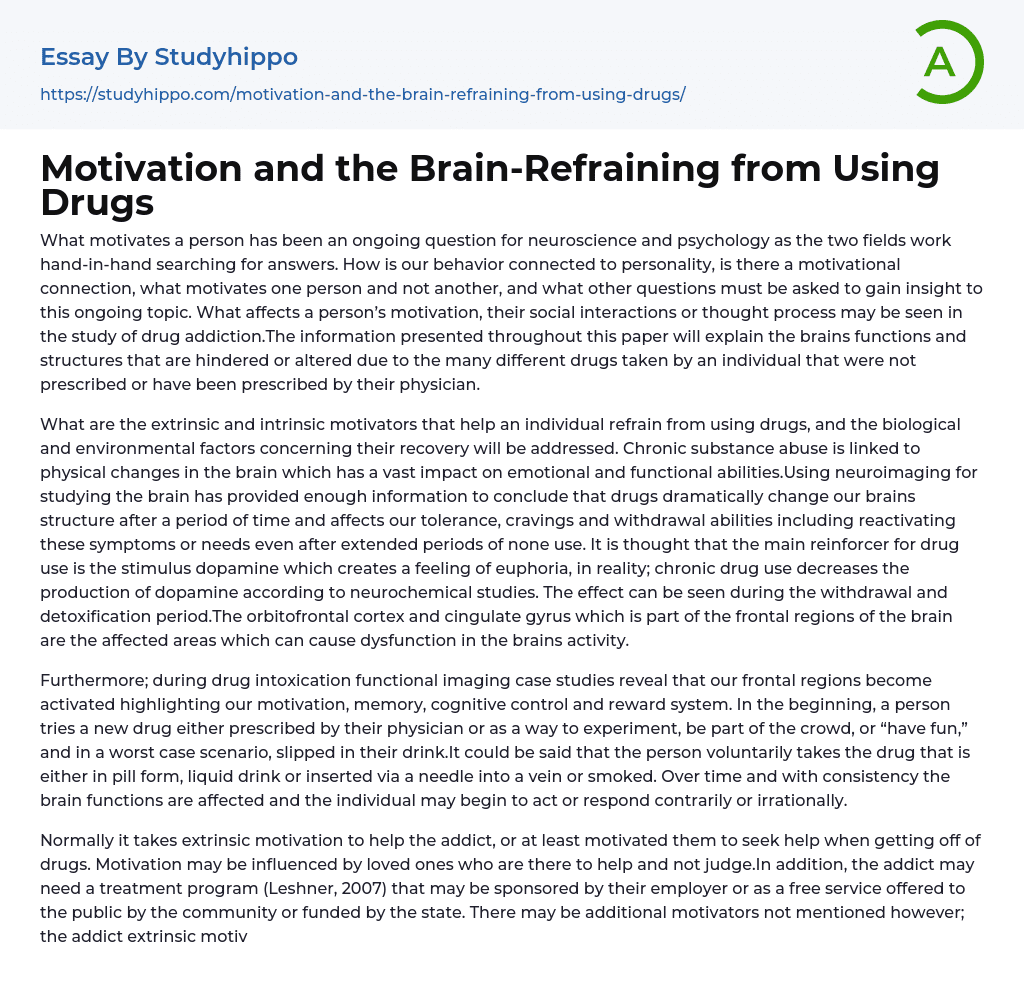

Motivation and the Brain-Refraining from Using Drugs Essay Example
Neuroscience and psychology continuously work together to seek answers about what drives human behavior, which raises questions such as the connection between behavior and personality, what motivates individuals and what factors influence motivation. The study of drug addiction sheds light on how social interactions or thought processes can impact motivation. This paper explores how non-prescription drugs or prescription drugs taken not as instructed can alter or hinder the brain's structures and functions.
To prevent substance abuse, it is important to address both extrinsic and intrinsic motivators due to the biological and environmental factors associated with recovery. Chronic drug use can cause physical changes in the brain that affect emotional and functional abilities. Neuroimaging studies have shown that drugs significantly alter brain structure, affecting tolerance, cravings, and withdrawal even after prolonged abstinence.
Drug use is primarily reinforced by
...dopamine which induces euphoric feelings. However, neurochemical studies show that chronic drug use reduces dopamine production during detoxification and withdrawal. Dysfunction in brain activity may occur specifically within the frontal regions of the brain such as the orbitofrontal cortex and cingulate gyrus.
Research using functional imaging has shown that the activation of frontal regions plays a crucial role in motivation, memory, cognitive control, and reward systems while under the influence of drugs. Drug use can be initiated either through medical prescription or for social, experimental, or recreational purposes. However, in some cases, drugs may be administered without an individual's knowledge by surreptitiously adding them to their drink. The drug can be voluntarily taken via oral ingestion of pills or liquid forms, injection or smoking; however, prolonged usage leads to changes in brain function which can cause irrational behavior.
The conventional approach t
aiding someone dealing with addiction involves utilizing extrinsic motivation, which may either urge them to seek assistance or inspire independent action. Assistance and support from compassionate individuals who provide non-judgmental help, as well as a treatment program suggested by various sources like employers, community services, or state-funded initiatives can be advantageous (Leshner, 2007). It should be acknowledged that while other factors could exist, extrinsic motivators have been consistently effective for those who voluntarily opt for treatment or those mandated to do so.
Overcoming addiction can be driven by various factors, including current situations, past events, and the highs and lows associated with drug use. The desire to stay sober can stem from potential consequences such as losing family, friends, jobs, homes, cars or suffering from health problems or sexual abuse. A system of incentives or strong internal motivators can aid those in recovery programs while words of encouragement can stimulate their drive if already engaged. Severe alcoholism may require relying on internal motivation when seeking treatment options like Alcohol Anonymous (AA).
The motivation to seek help and decision making towards recovery can be influenced by the severity of an alcoholic's addiction. Denial is a strong shield, which makes it difficult for them to admit being an alcoholic. Addiction involves both behavioral and biological components, which observers with opposing views can understand. Biobehavioral disorder is exemplified by drug addiction that has both behavioral and biological mechanisms involved in it. Ongoing research has uncovered cellular and molecular changes in the brain caused by drug use, which are also present in non-drug addictions such as pathological eating disorders (Leshner, 2007).
According to Westreich (2007), an addict's environment plays a crucial
and personal role in their recovery. This can be influenced by financial difficulties, transportation, or other circumstances. For example, living with drug-using individuals could make it challenging for one to resist temptation or feel the urge to relapse. In the early stages of recovery, an addict is vulnerable and more likely to relapse when continuing to associate with friends, family members, or coworkers who use drugs. Habits and patterns are difficult to break and classical conditioning can make it challenging to identify triggers that lead to relapses such as smoking a cigarette with a cocktail or after meals based on past experiences.
Environmental factors can cause cue-induced cravings that last for years and even persist when drugs are unavailable. Recovering addicts must change their environment to overcome the desire for drugs or environmental cues. Social habits can be difficult to break, and users may encourage drug use to access free drugs. Neuroscientific and psychological studies of drug addiction offer numerous avenues for understanding how our brain responds to different substances, which can alter our emotional and physical states, impair cognitive control, motivation and memory.
Extrinsic motivators are necessary to urge addicts to enter treatment programs before they experience devastating losses, such as their home, loved ones or engage in harmful activities such as child or spousal abuse. These motivators should also prioritize the addicts' physical well-being, including their teeth, as drugs can severely damage their health. Nonetheless, successful recovery requires more than just encouragement since biological factors may hinder progress.



